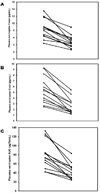Dose adjustment of the non-nucleoside reverse transcriptase inhibitors during concurrent rifampicin-containing tuberculosis therapy: one size does not fit all
- PMID: 19968575
- PMCID: PMC2939445
- DOI: 10.1517/17425250903393752
Dose adjustment of the non-nucleoside reverse transcriptase inhibitors during concurrent rifampicin-containing tuberculosis therapy: one size does not fit all
Abstract
Importance of the field: HIV/tuberculosis (TB) co-infection is common and associated with high mortality. Simultaneous highly active antiretroviral therapy during TB treatment is associated with substantial survival benefit but drug-drug interactions complicate NNRTI dosing.
Areas covered in this review: We reviewed the impact of rifampicin-containing TB therapy on the NNRTIs pharmacokinetics and clinical outcome. PubMed database was searched from 1966 to July 2009 using the terms efavirenz, rifampicin, nevirapine, pharmacokinetics, pharmacogenetics, HIV, TB, CYP2B6, CYP3A4 and metabolism. References from identified articles and abstracts from meetings were also reviewed.
What the reader will gain: A comprehensive review of the literature on this subject including pharmacokinetic and clinical studies. Most studies were small, observational or underpowered to detect the true effect of rifampicin on NNRTI-based therapy. None of the studies were controlled for genetic factors and there were limited data on children.
Take home message: There were insufficient data to make definitive recommendations about dose adjustment of the NNRTIs during rifampin-containing therapy. Current data suggest that the standard dose of efavirenz or nevirapine is adequate in most HIV/TB co-infected adults. However, more research is needed in pediatric populations as well as to define role of drug-gene interactions.
Conflict of interest statement
Dr Kwara has previously received a research grant not related to this work and had been on the speaker’s bureau of Bristol Myer-Squibb. Drs Ramachandran and Swaminathan declare no conflict of interest.
Figures



Similar articles
-
Pharmacokinetics of rifampin and isoniazid in tuberculosis-HIV-coinfected patients receiving nevirapine- or efavirenz-based antiretroviral treatment.Antimicrob Agents Chemother. 2014 Jun;58(6):3182-90. doi: 10.1128/AAC.02379-13. Epub 2014 Mar 24. Antimicrob Agents Chemother. 2014. PMID: 24663014 Free PMC article. Clinical Trial.
-
A randomized trial comparing plasma drug concentrations and efficacies between 2 nonnucleoside reverse-transcriptase inhibitor-based regimens in HIV-infected patients receiving rifampicin: the N2R Study.Clin Infect Dis. 2009 Jun 15;48(12):1752-9. doi: 10.1086/599114. Clin Infect Dis. 2009. PMID: 19438397 Clinical Trial.
-
Concomitant use of nonnucleoside analogue reverse transcriptase inhibitors and rifampicin in TB/HIV type 1-coinfected patients.AIDS Res Hum Retroviruses. 2008 Jul;24(7):897-901. doi: 10.1089/aid.2007.0277. AIDS Res Hum Retroviruses. 2008. PMID: 18671475 Clinical Trial.
-
Effectiveness and safety of antiretrovirals with rifampicin: crucial issues for high-burden countries.Antivir Ther. 2009;14(8):1039-43. doi: 10.3851/IMP1455. Antivir Ther. 2009. PMID: 20032533 Review.
-
Role of non-nucleoside reverse transcriptase inhibitors in treating HIV-infected children.Drugs. 2011 Nov 12;71(16):2131-49. doi: 10.2165/11597680-000000000-00000. Drugs. 2011. PMID: 22035514 Review.
Cited by
-
Establishing Dosing Recommendations for Efavirenz in HIV/TB-Coinfected Children Younger Than 3 Years.J Acquir Immune Defic Syndr. 2019 Aug 1;81(4):473-480. doi: 10.1097/QAI.0000000000002061. J Acquir Immune Defic Syndr. 2019. PMID: 31241542 Free PMC article. Clinical Trial.
-
Pharmacokinetics of efavirenz in patients on antituberculosis treatment in high human immunodeficiency virus and tuberculosis burden countries: A systematic review.Br J Clin Pharmacol. 2018 Aug;84(8):1641-1658. doi: 10.1111/bcp.13600. Epub 2018 May 22. Br J Clin Pharmacol. 2018. PMID: 29624706 Free PMC article.
-
When to start, what to start and other treatment controversies in pediatric HIV infection.Paediatr Drugs. 2012 Dec 1;14(6):361-76. doi: 10.2165/11599640-000000000-00000. Paediatr Drugs. 2012. PMID: 23013459
-
Integrase inhibitors versus efavirenz combination antiretroviral therapies for TB/HIV coinfection: a meta-analysis of randomized controlled trials.AIDS Res Ther. 2021 May 1;18(1):25. doi: 10.1186/s12981-021-00348-w. AIDS Res Ther. 2021. PMID: 33933131 Free PMC article.
-
Lack of association between plasma levels of non-nucleoside reverse transcriptase inhibitors & virological outcomes during rifampicin co-administration in HIV-infected TB patients.Indian J Med Res. 2013 Dec;138(6):955-61. Indian J Med Res. 2013. PMID: 24521642 Free PMC article.
References
-
- WHO. Global tuberculosis control - epidemiology, strategy, financing. WHO Report 2009. WHO/HTM/TB/2009411. 2009. [Last accessed August 13, 2009]. Available at http://www.who.int/tb/publications/global_report/2009/pdf/full_report.pdf.
-
- Dheda K, Lampe FC, Johnson MA, Lipman MC. Outcome of HIV-associated tuberculosis in the era of highly active antiretroviral therapy. J Infect Dis. 2004 Nov 1;190(9):1670–1676. - PubMed
-
- Manosuthi W, Chottanapand S, Thongyen S, Chaovavanich A, Sungkanuparph S. Survival rate and risk factors of mortality among HIV/tuberculosis-coinfected patients with and without antiretroviral therapy. J Acquir Immune Defic Syndr. 2006 Sep;43(1):42–46. - PubMed
-
- Velasco M, Castilla V, Sanz J, Gaspar G, Condes E, Barros C, et al. Effect of simultaneous use of highly active antiretroviral therapy on survival of HIV patients with tuberculosis. J Acquir Immune Defic Syndr. 2009 Feb 1;50(2):148–152. - PubMed
-
- Burman WJ. Issues in the management of HIV-related tuberculosis. Clin Chest Med. 2005 Jun;26(2):283–294. vi–vii. - PubMed
Publication types
MeSH terms
Substances
Grants and funding
LinkOut - more resources
Full Text Sources
Medical
Research Materials
